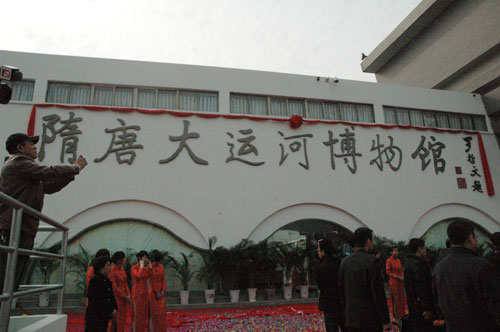
 |
| The Museum of the Grand Canal of the Sui and Tang dynasties (Xinhua) |
The Museum of the Grand Canal of the Sui and Tang dynasties was recently completed and will soon be open to the public. As an important capital of ancient China, Luoyang was the center of the Grand Canal during the Sui and Tang dynasties.
The museum of the Grand Canal of the Sui and Tang dynasties uses tools such as authentic items, photos and multimedia to exhibit the cultural heritage of the Grand Canal and narrate the relationship between Luoyang and the Grand Canal. It aims to help the public understand the significance of the canal, in terms of its impact on Chinese history.
The museum's picture exhibition was mainly divided into four parts, including the construction of the Grand Canal in the Sui and Tang dynasties, its prosperity and function, the canal, protection and application for inclusion on the world heritage list. The items displayed include some historic relics, such as structural parts of the riverbanks, food specimens from Hanjiancang and kiln models. Some typical historic relics were displayed by holographic projection to enhance the viewer experience.
There is an embossed hologram of the Grand Canal measuring 150 square meters, illustrating the canal's directions, distribution and the cities along the canal.
The Dance Building in Shan-Shan Guild Hall used to be a key performance venue in the ancient Tang Dynasty. Nowadays, a magical drama, Luoshenfu, will be presented to the audience in the Dance Building.
It has been recorded that Shan-Shan Guildhall was constructed in the Kangxi and Yongzheng reigns of the Qing Dynasty, with financial support from rich businessmen from Shanxi and Shaanxi provinces.
Shan-Shan Guildhall has been preserved and repaired since being placed under the supervision of cultural heritage sector in 1996. While the application for the list of heritage was taking place, the cultural heritage sector of Luoyang finally decided to rebuild the hall as the Grand Canal in the Sui and Tang Dynasty Museum following repeated considerations and discussions.
Shan-Shan Guildhall is the "attachment" of the Grand Canal, said Li Hong, the superintendent of the Shan-Shan Guildhall cultural relics maintenance bureau and curator of the Museum of the Grand Canal of Sui and Tang Dynasties. She added that although Shan-Shan Guildhall was built in the Qing Dynasty, far from the time of the Grand Canal of Sui and Tang, the hall was built just because the canal prospered.
As a fairly well-preserved group of architectures in the early Qing Dynasty, Shan-Shan Guildhall has many unique features: a great number of woodcarvings, stone carvings, antithetical couplets, which are the precious materials to research the folklores and customs of western Henan in Qing Dynasty.
















 Migrant children’s dream of stage
Migrant children’s dream of stage


![]()
